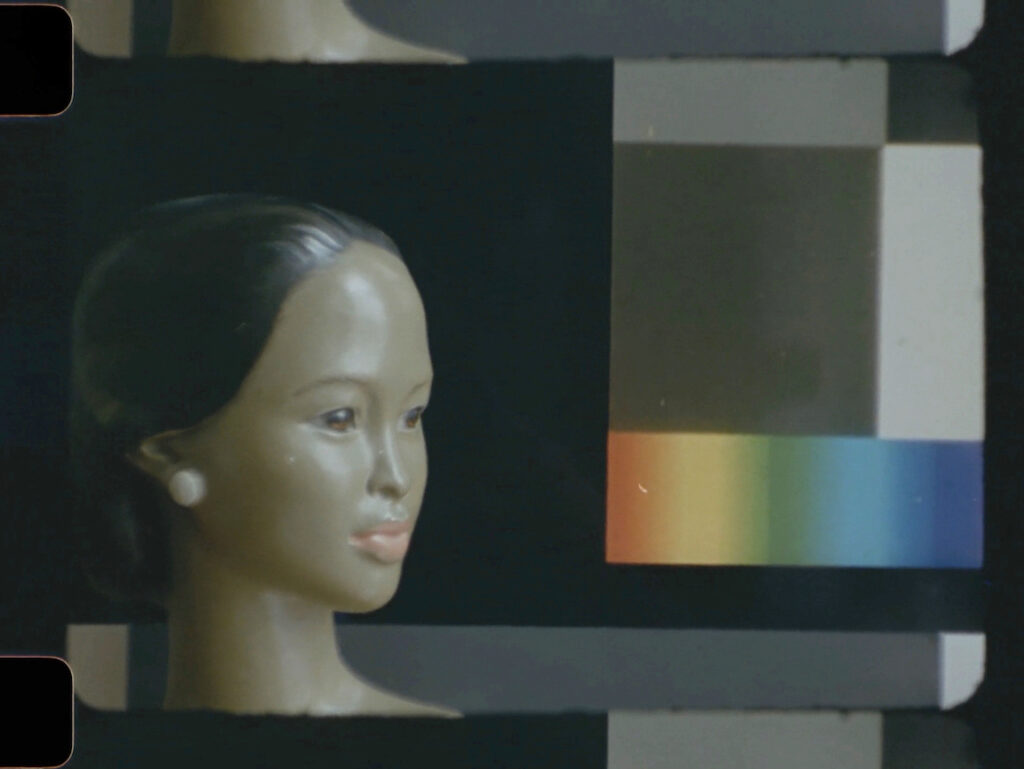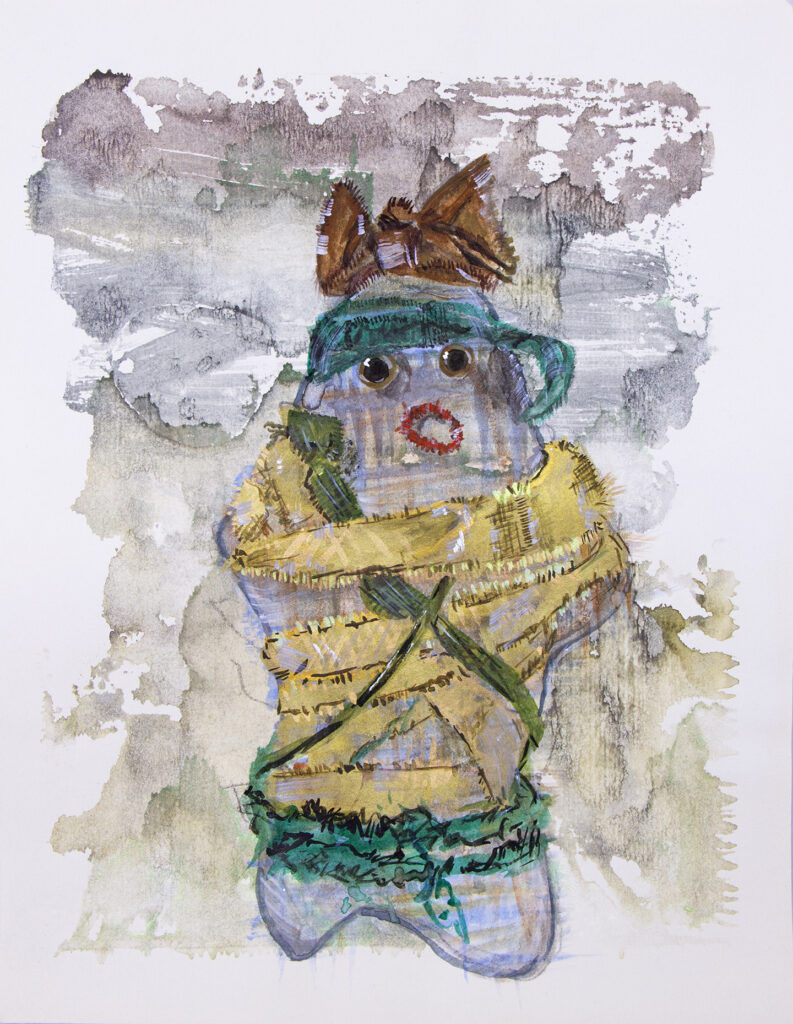Ina Archer
To Deceive the Eye
June 20 – July 27, 2024
Opening Thursday June 20, 6-8pm

Installation Views
Press:
The New Yorker, by Hilton Als
The New York Times, by Martha Schwendener
Artforum, Must See
Microscope is very pleased to present “To Deceive the Eye,” the second solo exhibition at the gallery of works by artist Ina Archer.
For “To Deceive the Eye” — the English translation of the French term “trompe-l’oeil” — Archer draws attention to the representation of African Americans and “the other” in cinema, the media, and the wider culture, from the mid-1800s until present day, highlighting the ways in which visual advancements have often been used to perpetuate stereotypes and racist tropes.
In her new multi-channel video installation, 16mm film, watercolors and other works on view, Archer employs, re-makes and re-edits original, found, and archival materials to re-contextualize images of blackness as a way to address, with sharp wit, themes of race and race relations including the legacy of minstrelsy, cultural appropriation, and erasure. Frequent visual deceptions are at play in the works such as those created by technological advancements in film and media as well as other trickeries employed by Archer.
Archer says of the works in the show: “All seem to be linked by (re)presenting images by “deceiving the eye” — Leader Ladies, color bars that are paint palettes, a painting that looks like a brooch that looks like a “Moor,” dolls that represent confused or composite ethnicities…”
For the video installation “Black Black Moonlight: A Minstrel Show,” the artist has unearthed footage spanning over 100 years from early films, television broadcasts, social media, and other sources, which she has edited and manipulated further into a three-channel composition. The format of the installation is based upon that of early minstrel shows with a large projection representing the center stage with its interlocutor, and monitors to the left and right serving as the two sidekicks.
The piece is built around an astonishing musical scene in a 1933 black & white Bing Crosby movie in which a woman contemplating suicide sings lyrics such as “Where everything reflects your color / Darkness that is endless …” from the song “Black Moonlight” while around her, the dancers — through a special b&w cinematic technique — repeatedly change skin tone from white to black, while also shifting choreography and tempo.
The many source materials range in time from a Thomas Edison’s minstrels from 1913 to the present day “accidental minstrelsy of videos of carbon facial mask peels being demonstrated in social media posts, sometimes by Black posters” and often repeat or flow across the channels. Other prominent footage is from the historical 1965 televised debate at the Cambridge Union Society in the UK on the motion “The American dream is at the expense of the American Negro,” between James Baldwin and William F. Buckley.
“I think Buckley’s performance recalls the blustery, speechifying featured in 19th century minstrel shows. And I believe the minstrel performer is like Jekyll and Hyde, two selves reside in the same body like a white person showing their “blackness” through blackface makeup or seamed together like topsy-turvy dolls.” – Ina Archer
Topsy-turvy dolls — consisting of two separate dolls, one black and one white joined together at the waist and with a double-sided skirt that flips to hide the other doll when held vertically — are also referenced in other scenes of the installation including the 1940s TV performance by the musical/comedic duo the Duncan Sisters, who perform in their long-running roles of “Topsy and Eva,” names taken from characters in the novel “Uncle Tom’s Cabin.”
In new works in watercolor, graphite, ink and charcoal on paper, Archer paints portraits of racially-charged dolls, statuettes, and other objects she has acquired over the years from vintage stores across the country and abroad as well as online, making slight, but significant adjustments to their stereotypical features. The works are the latest in an ongoing series by Archer which debuted at Frieze New York in 2021. Through the act of removing the underlying collectable from the market and the public exchange Archer also “liberates” the objects from new cycles of ownership that would otherwise prolong the effects of their symbology.
While Archer does not exhibit the actual objects discussed above, a few are surreptitiously inserted into starring roles in her 16mm film “Trompe l’Oeil: Black Leader” (3 minutes, color, sound, 2023). The work points to the problematic history of capturing non-white skin complexions on film and the use of mostly white “Leader Ladies” or “China Girls,” whose faces appear next to Kodak color charts at the start of films to help the lab technicians adjust the overall color settings. Inspired by her discovery that porcelain dolls or mannequins had been used prior to the adoption of live models, Archer’s dolls, ceramics, and other collected items are positioned next to a variety of actual color charts that have been used over the decades. The length of “Trompe l’Oeil: Black Leader” is equivalent to that of a single roll of uncut film and has purposefully not been “color corrected.”
“Ina Archer: To Deceive the Eye” opens June 20th, from 6pm to 8pm, and continues through July 27th. For further information please contact the gallery at inquiries@microscopegallery.com
_
Ina Archer is an artist working primarily with the mediums of drawing, collage, moving image, and installation, whose work examines the intersections of race/ethnicity, representation, and technology. Her works have been shown at institutions including Studio Museum in Harlem, New York, NY; White Columns, NY; The List Visual Arts Center at MIT, Cambridge, MA; Contemporary Art Museum, Houston, TX; Portland Museum of Contemporary Art, Portland, OR; and Spelman College Museum of Fine Art, Atlanta, GA, and many others. Her work has been reviewed in Artforum, Hyperallergic, and The New York Times, among others.
Archer was a Studio Artist in the Whitney Independent Study and has received grants and awards from Creative Capital, New York Foundation of the Arts (NYFA), Harvestworks, and the American Academy in Rome. Archer received a BFA from Rhode Island School of Design (RISD) and an MA in Cinema Studies from New York University (NYU). Ina Archer currently lives between Washington DC and Brooklyn, NY.

